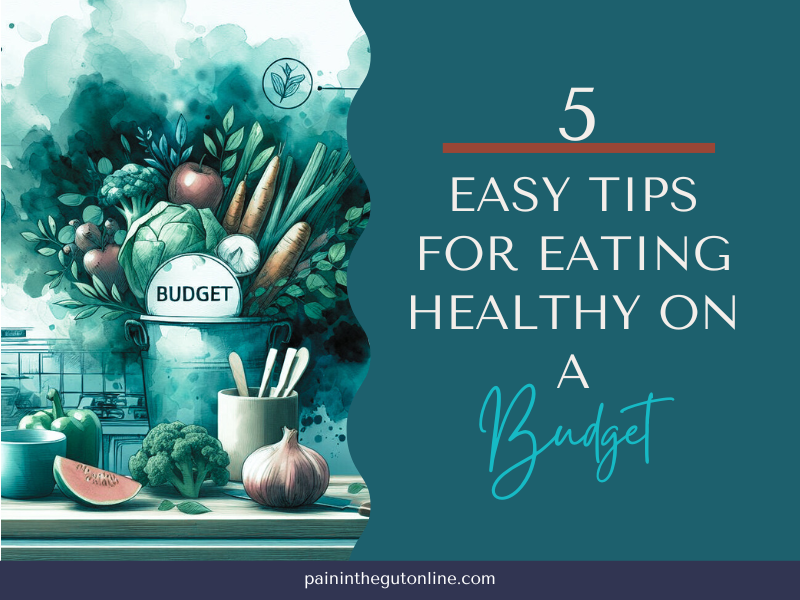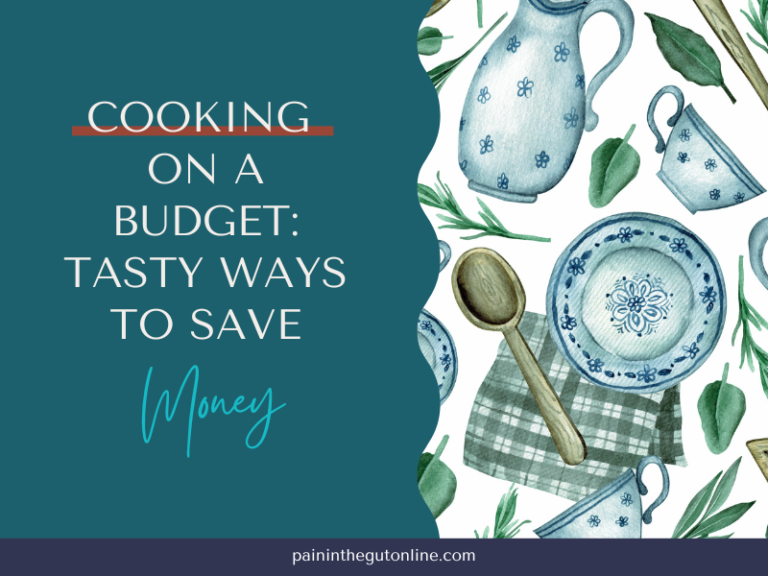EATING HEALTHY ON A BUDGET
10 min/2,081 words
Eat healthy without breaking the bank! Discover these five easy tips for eating healthy on a budget that won’t drain your wallet.

Table of Contents
Eating Well on a Budget
Many people believe that eating healthy requires a hefty budget. Guess what? With the right strategies and mindset, it’s totally possible to eat nutritious foods without breaking the bank.
Before we get into it, let’s explore the importance of eating healthy and the challenges of maintaining a nutritious diet on a budget.
Importance of Eating Healthy

Maintaining a healthy diet is essential for proper gut health and overall well-being. You know this. I know this.
A balanced diet gives your body the necessary nutrients, vitamins, and minerals to function optimally. It can help reduce the risk of chronic diseases, support weight management, boost energy levels, and improve mental health.
Yep. What you eat really does make a big impact on your health.
One of the simplest ways to invest in your long-term gut health and well-being is by prioritizing healthy eating.
Challenges of Eating Healthy on a Budget
While eating healthy is important, we know how challenging it can be to do so, especially on a limited budget.
Some common challenges you may experience include the higher cost of fresh produce, the temptation of cheaper processed foods, and the perception that healthy eating is expensive.
But it doesn’t have to be this way.
With careful planning and savvy shopping strategies, you can overcome these challenges and make nutritious choices without straining your finances.
You can navigate these challenges by creating a plan that matches your budget and goals.
By making intentional choices and being mindful of your spending, you can enjoy the benefits of a healthy diet without compromising your financial stability.
Now, let’s get into why you’re reading this article in the first place: practical strategies for planning meals, shopping smartly, and making healthy choices within your budget.
Five Easy Tips for Eating Healthy on a Budget

1. Planning Your Meals
Planning your meals is an absolutely essential step when it comes to eating healthy on a budget.
By creating a weekly meal plan and making a detailed grocery list, you can ensure that you have all the necessary ingredients for nutritious and budget-friendly meals throughout the week.
Plus, when you have a solid plan in place, you can avoid impulse shopping.
Create a Weekly Meal Plan
Start by setting aside some time each week to create a meal plan. I love to do this on Saturday, then shop and prep on Sunday.
This involves deciding what meals you will have for breakfast, lunch, and dinner for the upcoming week. Including a variety of fruits, vegetables, whole grains, and lean proteins in your plan is a must for healthy eating.
By planning your meals in advance, you can avoid last-minute unhealthy food choices or unnecessary trips to the store. It also allows you to make the most of the ingredients you have on hand and reduce food waste.
If you need inspiration for budget-friendly healthy meals, check out our article on budget-friendly healthy meals.
Make a Detailed Grocery List
Once you have your meal plan ready, it’s time to make a detailed grocery list.
Look at each recipe or meal you plan and note the ingredients you need. Check your pantry and refrigerator to see if you already have some of the items on hand.
Organize your grocery list by categories such as fruits and vegetables, proteins, grains, and pantry staples. This will make your shopping experience more efficient and help you stick to your budget.
*Pro tip: Use a grocery pickup option to help you stick to your budget and avoid temptation, like those new Lay’s Hot Honey potato chips ; )
When you create a weekly meal plan and make detailed grocery lists, you can control your eating habits while staying within your budget. This strategy also enables you to make the most of your ingredients, reduce food waste, and save time and money in the long run.
For additional tips on budget meal prep and cooking on a budget, check out our articles on budget meal prep and cooking on a budget.
2. Smart Shopping Strategies

Adopting smart shopping strategies can make a significant difference when it comes to eating healthy on a budget. By following these tips, you can stretch your dollars while filling your cart with gut-friendly nutritious options.
Buy in Bulk When Possible
Buying in bulk is an effective way to save money on groceries.
Purchasing larger quantities of non-perishable items, such as grains, legumes, nuts, and seeds, allows you to take advantage of lower unit prices. These items can be stored for extended periods, ensuring that you always have a budget-friendly and nutritious pantry staple on hand.
Consider joining a wholesale club or purchasing items from bulk bins in grocery stores. This way, you can buy as much or as little as you need, reducing food waste and saving money in the long run.
Remember to store bulk purchases properly to maintain their freshness and quality.
Look for Sales and Discounts
Keeping an eye out for sales and discounts can significantly impact your grocery budget.
Take the time to browse weekly circulars, digital coupons, and promotional offers from your local grocery stores. By strategically planning your shopping trips around these deals, you can save money on a variety of nutritious foods.
Take advantage of loyalty programs offered by your favorite stores.
These programs often provide exclusive discounts and rewards for regular customers. By signing up and using your loyalty card, you can maximize your savings and stretch your budget even further.
Choose Seasonal Produce
Opting for seasonal produce is a cost-effective choice and ensures that you enjoy the freshest and most flavorful fruits and vegetables.
Seasonal produce is abundant and readily available, lowering prices compared to out-of-season options. Plus, you contribute to your community’s economy by supporting local farmers and markets.
By implementing these smart shopping strategies, you can eat healthy on a budget without compromising quality or nutrition.
Remember, it’s not just about saving money; it’s about making conscious choices that benefit your health and well-being.
3. Cooking at Home

Cooking at home is not only a great way to save money but also allows you to have full control over the ingredients you use, allowing you to make healthier choices.
If you don’t usually cook, this might be a real pain in the backside for a while, but if you’re devoted to eating healthier while staying on budget, then cooking at home is a must.
Here are two strategies for eating healthy on a budget: cooking in batches and freezing and using affordable and nutritious ingredients.
Cook in Batches and Freeze
One of the most effective ways to save time and money when cooking at home is by preparing meals in larger quantities and freezing the leftovers.
This lets you take advantage of sales and discounts on ingredients while minimizing food waste. By cooking in batches, you can portion the meals and store them in the freezer for later use.
This way, you’ll always have a nutritious and budget-friendly meal option readily available, even on busy days.
To make batch cooking easier, consider investing in freezer-safe containers or freezer bags. Label each container with the dish’s name and the date it was prepared to keep track of freshness.
Certain foods like soups, stews, casseroles, and sauces freeze particularly well.
Use Affordable and Nutritious Ingredients
Cooking healthy meals on a budget doesn’t mean compromising on nutrition.
In fact, you might be surprised to learn how eating whole, minimally processed foods will actually save you money over buying the more expensive precooked or pre-prepped varieties.
Choosing affordable and nutritious ingredients allows you to create delicious and wholesome dishes without breaking the bank.
Here are some examples of budget-friendly ingredients that provide a good balance of nutrients:
- lentils
- dried or canned beans
- frozen fruits and vegetable
- eggs
- whole grains, oats, rice, quinoa
- seasonal fresh produce
By incorporating these ingredients into your meals, you can create various nutritious dishes while keeping your budget in check.
Combine them with herbs, spices, and pantry staples like olive oil and vinegar to add flavor without unnecessary cost.
Remember, cooking at home saves money and puts you in control of your food choices. You can enjoy delicious and healthy meals by cooking in batches and utilizing affordable and nutritious ingredients while sticking to your budget.
4. Making Healthy Choices

When it comes to eating healthy on a budget, making smart food choices is key.
By opting for whole foods and limiting highly processed and pre-packaged foods, you can improve your nutrition while keeping your expenses in check.
Opt for Whole Foods
Choosing whole foods is an excellent way to nourish your body with essential nutrients without breaking the bank. Whole foods are minimally processed and retain their natural goodness.
They are rich in vitamins, minerals, fiber, and other beneficial compounds that support your overall health.
Here are some examples of whole foods to incorporate into your diet:
- fresh or frozen fruits
- fresh or frozen vegetable
- wholes grains, rice, bread, oats,
- lean proteins, chicken, fish, tofu, beans
- dairy or dairy alternatives, greek yogurt, soft cheeses
Focusing on whole foods can help you create balanced and nutritious meals that are good for your body and your wallet.
Limit Processed and Pre-Packaged Foods
While convenient, highly processed and pre-packaged foods tend to be higher in added sugars, unhealthy fats, and sodium. These items often come with a higher price tag as well.
By reducing your consumption of these foods, you can improve your diet quality and save money.
Here are some examples of processed and pre-packaged foods to limit:
- sugary snacks, packed cookies, candies, baked goods, and sugary cereals
- salty snacks, chips, and crackers
- frozen dinners, pizzas, pre-packed meals and appetizers
- sugary drinks, soda, fruit juices, sweetened teas, and energy drinks
Instead of relying on these options, try preparing your meals at home using fresh, whole ingredients. Cooking on a budget can be enjoyable and cost-effective.
By making conscious choices to opt for whole foods and limiting processed and pre-packaged foods, you can prioritize your health while managing your budget effectively.
Remember, small changes in your eating habits can lead to significant long-term benefits.
5. Additional Tips

When it comes to eating healthy on a budget, several additional tips can help you make the most of your money while still nourishing your body. You can eat well without breaking the bank by utilizing coupons and loyalty programs, growing your produce, and learning basic cooking skills.
Utilize Coupons and Loyalty Programs
Coupons and loyalty programs can be a great way to save money on your grocery bills.
Look for coupons in newspapers, magazines, and online platforms. Many grocery stores also have loyalty programs that offer discounts and special deals to members.
By taking advantage of these opportunities, you can save money on your purchases and stretch your budget further.
Grow Your Produce
Growing your produce can be a rewarding and cost-effective way to eat healthy.
Even if you have limited space, you can grow herbs, salad greens, and certain vegetables in pots or small containers. This not only saves you money on buying produce, but it also ensures that you have fresh, organic options readily available.
If you’re new to gardening, start with easy-to-grow plants like tomatoes, herbs, or lettuce.
Learn Basic Cooking Skills to Save Money
Learning basic cooking skills is a valuable life skill and a great way to save money.
Cooking meals at home allows you to control the ingredients, portion sizes, and costs. Experiment with simple, budget-friendly recipes that use affordable ingredients.
Cooking in bulk and meal prepping can also help you save time and money.
Prepare large batches of meals and freeze them in portions for future use. This way, you can avoid relying on expensive takeout or convenience foods when you’re short on time.
Implementing these additional tips can help you maximize your budget while still enjoying nutritious meals.
Eating healthy on a budget doesn’t have to be expensive.
If you’re looking for healthy recipes to help you stay on budget, grab our 5 Free No-Cook Recipes for Gut Health here.







